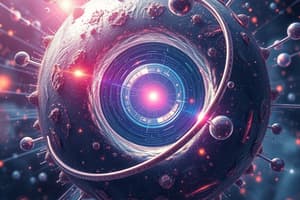Podcast
Questions and Answers
What term did the Greeks use to describe the smallest part of matter?
What term did the Greeks use to describe the smallest part of matter?
- Atom (correct)
- Molecule
- Essence
- Particle
What four basic substances did the Greeks believe made up all matter?
What four basic substances did the Greeks believe made up all matter?
- Water, Earth, Fire, and Metal
- Earth, Water, Air, and Lightning
- Wind, Fire, Earth, and Light
- Fire, Earth, Water, and Air (correct)
Which scientist laid the foundation for modern atomic theory in 1808?
Which scientist laid the foundation for modern atomic theory in 1808?
- Dmitri Mendeleev
- Niels Bohr
- Isaac Newton
- John Dalton (correct)
According to Dalton, how do atoms of the same element behave?
According to Dalton, how do atoms of the same element behave?
What did the Greeks use to represent different types of atoms?
What did the Greeks use to represent different types of atoms?
How many substances or elements have been identified as of now?
How many substances or elements have been identified as of now?
What was the significant contribution of Dmitri Mendeleev to chemistry?
What was the significant contribution of Dmitri Mendeleev to chemistry?
Which four basic essences did the Greeks associate with their theory of matter?
Which four basic essences did the Greeks associate with their theory of matter?
What does the atomic number represent in the periodic table?
What does the atomic number represent in the periodic table?
What is the main characteristic of the elements in group I of the periodic table?
What is the main characteristic of the elements in group I of the periodic table?
Which model of the atom introduced the concept of a nucleus?
Which model of the atom introduced the concept of a nucleus?
What are halogens known for regarding their interactions with metals?
What are halogens known for regarding their interactions with metals?
What was J.J. Thomson's contribution to atomic theory?
What was J.J. Thomson's contribution to atomic theory?
What is a defining feature of noble gases in the periodic table?
What is a defining feature of noble gases in the periodic table?
In Bohr's model of the atom, how do electrons behave?
In Bohr's model of the atom, how do electrons behave?
Why was the periodic table initially incomplete?
Why was the periodic table initially incomplete?
Study Notes
Structure of Matter
- Ancient Greeks, including Pythagoras and Archimedes, proposed matter was composed of four substances: earth, water, air, and fire.
- They believed these substances were influenced by four essences: wet, dry, hot, and cold.
- The term "atom" originates from Greek, meaning "indivisible," referring to the smallest part of matter in their theories.
- Currently, 118 elements have been identified: 92 naturally occurring and 26 artificially produced in particle accelerators.
- Atoms are now understood to be the smallest particle of an element, with smaller particles referred to as subatomic particles.
John Dalton's Contributions
- In 1808, John Dalton published foundational work defining elements as composed of identical atoms that react uniformly.
- Dalton visualized atom interactions as an "eye-and-hook" mechanism, illustrating the joining of different atoms.
- His classification of elements was based on integral values of atomic mass, laying groundwork for modern atomic theory.
Dmitri Mendeleev and the Periodic Table
- Mendeleev arranged elements by increasing atomic mass, revealing periodic repetition in chemical properties.
- His creation of the first periodic table organized about 65 elements into eight groups, though many gaps existed.
- Each group in the periodic table exhibits similarities in chemical behavior and physical properties.
- Group I includes alkali metals, soft and reactive; Group VII comprises halogens, which form salts; Group VIII contains noble gases, resistant to reactions.
Advances in Atomic Theory
- Prior to the 20th century, atoms were considered indivisible, differing only in mass among elements.
- J.J. Thomson identified electrons as components of all atoms in the late 1890s, proposing the "plum pudding" model of atomic structure.
- Thomson's model depicted electrons (negative charges) embedded in a uniform positive mass.
- Ernest Rutherford challenged Thomson's model in 1911, introducing the nuclear model with a dense positively charged nucleus surrounded by electrons.
Niels Bohr's Model
- Niels Bohr refined Rutherford's model in 1913, likening atomic structure to a miniature solar system with electrons orbiting the nucleus.
Studying That Suits You
Use AI to generate personalized quizzes and flashcards to suit your learning preferences.
Description
Explore the ancient philosophies surrounding the structure of matter as understood by early Greek thinkers like Pythagoras and Archimedes. This quiz delves into the foundational concepts that shaped scientific inquiries into the nature of substances and their combinations. Test your knowledge of these age-old theories and their significance in the evolution of scientific thought.




